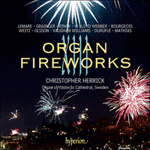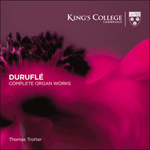
Welcome to Hyperion Records, a British classical label devoted to presenting high-quality recordings of music of all styles and from all periods from the twelfth century to the twenty-first.
Hyperion offers both CDs, and downloads in a number of formats. The site is also available in several languages.
Please use the dropdown buttons to set your preferred options, or use the checkbox to accept the defaults.

The first variation is written in four parts. The theme appears in the pedals whilst the right hand plays an elaboration of the theme. The second variation is for manuals only, whilst the third variation is a canon at the interval of the fourth. The final variation is a brilliant toccata, introducing the theme in canon between right hand and pedals. The music winds up to a glorious climax; Duruflé saves his master-stroke for the coda marked ‘tempo poco più vivo’ when he presents the plainsong ‘Amen’ (only hinted at in the organ music until that point) in the pedals on full organ.
from notes by William McVicker © 1990
extrait des notes rédigées par Relf Clark © 2009
Français: Hypérion
aus dem Begleittext von Relf Clark © 2009
Deutsch: Renate Wendel
 Organ Fireworks, Vol. 13 Organ Fireworks, Vol. 13Christopher Herrick continues the Scandinavian leg of his endlessly popular Organ Fireworks series with a disc of music performed on the great organ of Västerås Cathedral in Sweden. The programme is, as ever, a tempting potpourri of pieces from ar ...» More |
 Duruflé: Complete organ works Duruflé: Complete organ worksThomas Trotter is a prize-winning concert organist and one of the UK’s most admired performing musicians, reflected in Her Majesty The Queen awarding him The Queen’s Medal for Music on St Cecilia’s Day 2020.» More |

